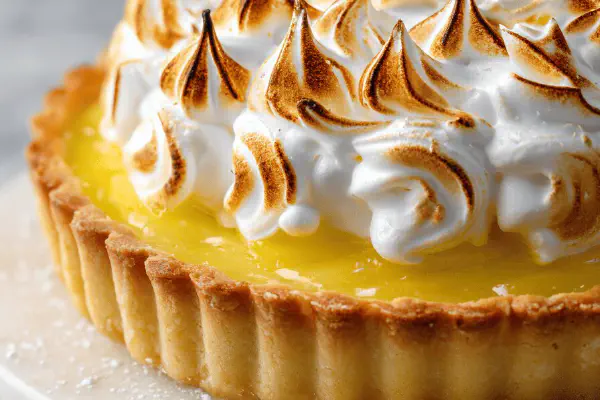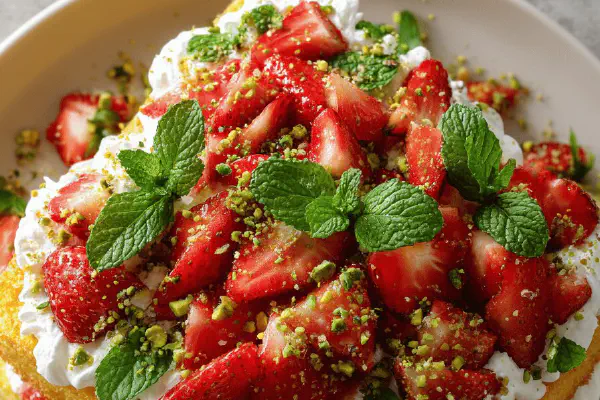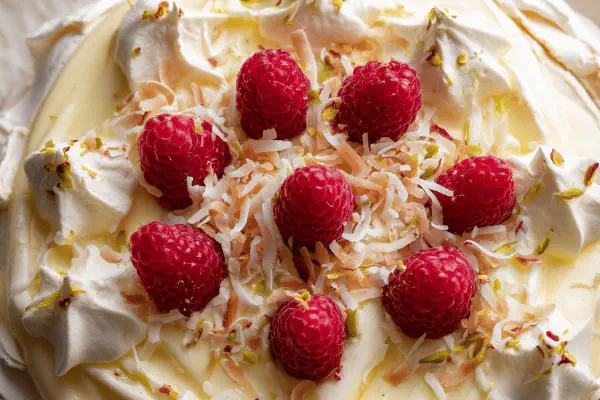Swiss Meringue Lemon Tart

By Emma
Certified Culinary Professional
Ingredients
Lemon Filling
- 150 ml fresh lemon juice roughly 2 large lemons
- 100 ml unsalted butter chopped
- 3 whole eggs
- 120 ml granulated sugar
- pinch salt
- 1/2 teaspoon finely grated fresh ginger root
Crust
- 1 23 cm tart shell baked blind (shortcrust or sweet dough)
Swiss Meringue
- 100 ml granulated sugar
- 4 egg whites
About the ingredients
Method
Prepare Filling
- 1. Set oven rack lower third; preheat to 175 C (347 F).
- 2. In a small saucepan, bring lemon juice, butter, and grated ginger just to a simmer. Aroma sharp but warm. Remove promptly.
- 3. In a clean bowl, whisk eggs, sugar, and salt until combined but not foamy.
- 4. Gradually add warm lemon mixture to eggs, whisking continuously to avoid scrambling.
- 5. Return entire mixture to saucepan. Heat over medium, whisking constantly. Look for jiggle thickening, not full boil—around 11–12 minutes. Remove at first foamy bubble formation. Texture should coat spoon with a thick veil, almost pudding-like.
- 6. Strain through fine mesh to remove cooked bits and zest. Pour into baked crust cradle. Slide into oven to bake 14 minutes or until filling edges set but center still slightly wobbly. Slight sinking indicates doneness within distinction. Let cool for 30 minutes at room temp then chill 90 minutes minimum; cold filling holds meringue better.
Swiss Meringue
- 7. Set up double boiler or bain-marie. Combine egg whites and sugar in heatproof bowl over simmering water—not boiling. Constant stir to dissolve sugar fully. Test with fingers—no grit means ready. Target temp 60–65 C (140–149 F).
- 8. Immediately remove bowl. Use electric mixer to whisk whites on medium-high. Watch transformation from shiny gloss to stable peaks. Should be cool to touch before use, around 5–7 minutes of whipping. Important: hot meringue deflates easily if rushed to oven.
Assemble and Torch
- 9. Heat oven broiler to high. Spread meringue thick over chilled lemon layer, sealing edges to prevent shrinking. Look for soft pillowy height, soft peaks, no gaps.
- 10. Broil 1–3 minutes, carefully watching amber spots develop. Brown but not burnt—smoke means too far. Alternate broiler power among ovens; some hotter than others. If worried, use kitchen torch to brown evenly.
- 11. Consume day made for crisp meringue and fresh zing. Refrigerate leftovers up to 2 days; crust may soften.
Tips & Tricks
- Avoid undercooking filling or it’ll be soupy at slicing. Use fresh lemons; bottled juice lacks bite. Ginger adds unexpected warmth offsetting sweetness. If egg white volume drops, dry bowl or whisk likely culprit. Meringue too runny? Sugar not dissolved fully. Use metal or glass bowls for meringue (no plastic). Blind bake crust with pie weights to prevent sogginess under filling. Allow entire tart to cool fully before meringue.
- If no bain-marie, microwave sugar+whites in bursts whisking between, watching temperature carefully. Don’t rush stirring or fluffing; this is where failed meringues happen most.
- Older eggs whites sometimes fluff better but can dry out faster under heat. Freshness balanced with technique.
- Remember smells—lemon steam sharp but buttery richness melds, meringue sweet egg aroma toasted wood smokes notes alarms if burning. Visuals more than timers; listen to quiet cues.
Cooking tips
Chef's notes
- 💡 Heat lemon juice, butter, and ginger just to simmer; remove immediately or butter breaks down. Ginger adds warmth but too much bites hard. Constant whisk when adding lemon mix to eggs prevents scrambling; gradual pour saves texture.
- 💡 Strain cooked filling through fine mesh to catch clumps and zest bits. Baking filling until edges set with a slight wobble in middle nails creamy finish. Let cool before chilling; cold filling holds meringue better — no mix or shrink.
- 💡 Swiss meringue needs sugar fully dissolved—gritty means no peaks. Use a double boiler not boiling water or microwave in bursts, stirring between runs. Target 60–65 C temp landing zone; less, meringue falls flat, more risks curdle.
- 💡 Whip whites on medium-high after heating; watch gloss turn to stiff peaks. Cool to touch before spreading. Hot meringue collapses under heat. Spread thick; seal edges tight or meringue shrinks or leaks during broil or torching phase.
- 💡 Broil with steady eye; amber spots, not charcoal black. Smoke signals overdone. Kitchen torch on hand helps fix uneven browning fast. Older egg whites fluff better (dry bowls mandatory). Underbaked filling yields runny tart; filler must jiggle thick, not set hard.
Common questions
How to prevent scrambled lemon filling?
Gradual adding warm lemon mix to eggs while whisking nonstop. Don’t rush. Heat on medium low; watch for thick jiggle, not rapid boil. Strain after cooking helps remove bits.
Best way to make Swiss meringue?
Use double boiler with simmer water. Stir sugar and whites constantly till no grit. If no stove, microwave in short bursts stirring in-between. Target 60–65 C is key. Electric mixer whipping after, peaks must be stable and glossy.
Why is my meringue runny or collapses?
Sugar not dissolved fully or whites too warm. Whip cool meringue only. Bowls or utensils with fat ruin volume. Use metal/glass. Fresh or day-old whites behave differently but technique trumps freshness sometimes.
How to store leftovers?
Keep in fridge sealed 1–2 days max. Meringue softens fast but crust stays crisp longer if blind baked well. Reheat broiler quick touch or torch if top dulls. Filling chilled holds layers distinct but avoid long storage.



